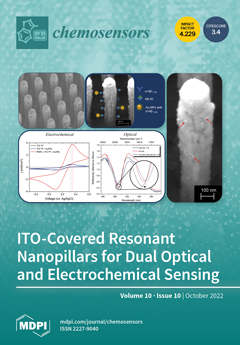Using the first-principles theory, the geometric and electronic properties of the Ru-doped PtTe
2 (Ru-PtTe
2) monolayer, and its sensing performance for three VOCs biomarkers, namely, 2-propenal (C
3H
4O), acetone (C
3H
6O) and isoprene (C
5
[...] Read more.
Using the first-principles theory, the geometric and electronic properties of the Ru-doped PtTe
2 (Ru-PtTe
2) monolayer, and its sensing performance for three VOCs biomarkers, namely, 2-propenal (C
3H
4O), acetone (C
3H
6O) and isoprene (C
5H
8), were analyzed, to expound its potential for exhaled breath analysis and diagnosis of lung cancer. It was found that the Ru-substitution on the surface of the pristine PtTe
2 surface with a Te atom is energy-favorable, with the formation energy of −1.22 eV. Upon adsorption of the three VOC gas species, chemisorption was identified with the adsorption energies of −1.72, −1.12 and −1.80 eV for C
3H
4O, C
3H
6O and C
5H
8, respectively. The Ru-doping results in a strong magnetic property for the PtTe
2 monolayer, whereas the gas adsorption eliminates this magnetic behavior. The electronic properties reveal the sensing mechanism of the Ru-PtTe
2 monolayer for gas detection, and the bandgap change indicates its admirable positive sensing response for the three gas species. Therefore, we conclude that the Ru-PtTe
2 monolayer is a promising sensing material to realize the diagnosis of lung cancer through exhaled gas detection, with a remarkable decrease in its electrical conductivity. This work paves the way for further exploration of the PtTe
2-based gas sensor for early diagnosis of lung cancer, and we hope that more sensing materials can be investigated using the PtTe
2 monolayer.
Full article





